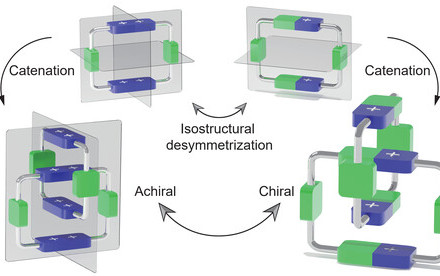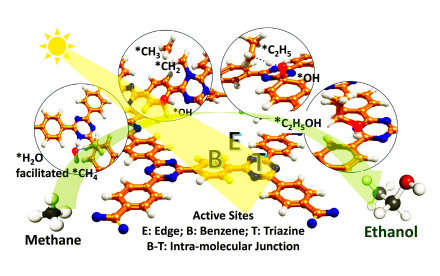12 Dec 2022
Catalysing ‘Net-Zero’ Green Hydrogen from the Sun: HKU Chemists Discover a Fundamental Catalyst Protonation Process to Promote Solar-Driven Water-Splitting for Hydrogen Production without CO2 Emissions

Chemists at HKU discover a fundamental catalyst protonation process to enhance productivity of solar-driven water-splitting for hydrogen by eight times, catalysing green energy without CO2 emissions.
Hydrogen is a promising green energy carrier for a sustainable future. However, it is mostly locked in water. Energy is required to liberate it from water for practical use. Solar energy is abundantly renewable, ideal for direct water-splitting to generate hydrogen using a ‘photocatalyst’. However, despite of considerable effort, practical adoption has been slow due to relatively low efficiency and high cost of the catalyst.
A research team led by Professor Zheng-Xiao GUO and Professor David Lee PHILLIPS from the HKU-CAS Joint Laboratory on New Materials and the Department of Chemistry of The University of Hong Kong (HKU), has reported the discovery of an important in-situ protonation process that the photodynamics and separation of charge carriers in a photocatalyst, leading to efficient hydrogen generation from water using visible solar light. The process is enabled in an interstitial phosphorus doped carbon nitride structure, with only earth-abundant non-metallic elements, for its cost-effectiveness and high potential for practical applications. The research findings are recently published online in a top scientific journal, Energy & Environmental Science.
Background and Achievement
Extensive research efforts have been devoted to the development of photocatalysts for solar-driven energy conversion with improved activity, efficiency and durability, mostly via: charge separation, transfer and utilisation. However, the complex multi-electron transfer, proton coupling and intermediate dynamics can all influence the photocatalytic pathway, kinetics and efficiency, which have not been well understood. It is thus highly desirable to foster in-depth investigations integrating innovative synthesis design, microscopic and spectroscopic characterisations and atomic simulations at the molecular level.
Extensive research efforts have been devoted to the development of photocatalysts for solar-driven energy conversion with improved activity, efficiency and durability, mostly via: charge separation, transfer and utilisation. However, the complex multi-electron transfer, proton coupling and intermediate dynamics can all influence the photocatalytic pathway, kinetics and efficiency, which have not been well understood. It is thus highly desirable to foster in-depth investigations integrating innovative synthesis design, microscopic and spectroscopic characterisations and atomic simulations at the molecular level.
With full appreciation of the current efforts and the challenges in photocatalysis, the HKU team examined the fundamental issues from a different angle and proposed a new fundamental process of a proton-mediated photocatalytic mechanism to enhance the photo-dynamics, charge separation and hence the overall efficiency of an interstitial phosphorus-doped carbon-nitride, g-C3N4. The in-situ proton-mediated mechanism points to a new role of the water molecule, not just as a solvent or reactant but as an effective band-structure modifier of the catalyst in the overall design of effective photocatalytic processes.
In essence, the team has developed an effective atomic heterojunction by porosity-stabilised interstitial P-doping and in-situ protonation to induce shallow trap states, which effectively: a) enhance the lifetime of the excited states and b) restrain undesirable deep charge trapping, leading to efficient water decomposition. For the first time, the team has identified that the in-situ protonation of an interstitially anchored phosphorus in a holey g-C3-xN4 is a very effective structural configuration of the catalyst for highly efficient and stable visible-light hydrogen generation.
‘We expect that our discovery will open up a new line of thinking in the future design of photocatalysts for effective solar energy utilisation, by paying more attention to operando structural dynamism as a viable handle to pump up the conversion efficiency,’ said Professor Zheng-Xiao Guo.
‘Spectroscopic investigations show a colourful world of nanomaterials, and it will cast more light on the mechanistic insights of science and technologies,’ echoed Professor David Lee Phillips.
About Professor Zheng-Xiao Guo
Professor Zheng-Xiao Guo is a joint-faculty Professor of Chemistry and Mechanical Engineering at HKU, an Honorary Professor at the University College London (UCL), an Elected Member of Academia Europaea (The Academy of Europe), as well as a Fellow of the Royal Society of Chemistry and a Fellow of the Institute of Materials, Minerals and Mining. He was a Professor of Chemistry at UCL (2007-18), and prior to this, a Lecturer (1995-98), Reader (1998-99) and Professor (2000-07) at Queen Mary, the University of London. He was a research fellow at the University of Oxford (1990-95), and of Strathclyde (1988-90), respectively, with a PhD and an MRes from the University of Manchester in 1988 and 1984, and a BEng in Materials Science from the Northeastern University/China in 1983, respectively.
More information about his research group: https://zxguo.hku.hk/
Professor Zheng-Xiao Guo is a joint-faculty Professor of Chemistry and Mechanical Engineering at HKU, an Honorary Professor at the University College London (UCL), an Elected Member of Academia Europaea (The Academy of Europe), as well as a Fellow of the Royal Society of Chemistry and a Fellow of the Institute of Materials, Minerals and Mining. He was a Professor of Chemistry at UCL (2007-18), and prior to this, a Lecturer (1995-98), Reader (1998-99) and Professor (2000-07) at Queen Mary, the University of London. He was a research fellow at the University of Oxford (1990-95), and of Strathclyde (1988-90), respectively, with a PhD and an MRes from the University of Manchester in 1988 and 1984, and a BEng in Materials Science from the Northeastern University/China in 1983, respectively.
More information about his research group: https://zxguo.hku.hk/
About Professor David Lee Phillips
Professor David Lee Phillips is a Chair Professor at HKU Department of Chemistry. As an internationally recognised chemist, he uses time-resolved spectroscopy experiments and quantum mechanical calculations to study short-lived intermediates in chemical reactions of interest in chemistry, biology and the environment. He has published more than 350 internationally refereed scientific journal articles listed in Science Citation Index.
He serves on the Editorial Advisory Board of the journal Molecules and also on the Advisory Board of the Journal of Physical Organic Chemistry. Professor Phillips graduated with a PhD from the University of California, Irvine.
More information about his research group: https://sites.google.com/view/dlplab/home?pli=1
More information about his research group: https://sites.google.com/view/dlplab/home?pli=1
About the Research Team
Dr Wenchao WANG (Postdoctoral fellow) from Professor Guo’s group is the first author. Professor Lili DU from the Jiangsu University, Professor Hung Kay LEE from the Chinese University of Hong Kong and other HKU researchers (including Miss Ruiqin XIA; Dr Runhui LIANG; Mr Tao ZHOU; Dr Zhiping YAN; Miss Hao LUO; Dr Congxiao SHANG) in the Department of Chemistry contributing to the research.
Dr Wenchao WANG (Postdoctoral fellow) from Professor Guo’s group is the first author. Professor Lili DU from the Jiangsu University, Professor Hung Kay LEE from the Chinese University of Hong Kong and other HKU researchers (including Miss Ruiqin XIA; Dr Runhui LIANG; Mr Tao ZHOU; Dr Zhiping YAN; Miss Hao LUO; Dr Congxiao SHANG) in the Department of Chemistry contributing to the research.
Supplementary Information
W. Wang, L. Du, R. Xia, R. Liang, T. Zhou, H. K. Lee, Z. Yan, H. Luo, C. Shang, D. L. Phillips,* Z. X. Guo* “In-situ protonated-phosphorus interstitial doping induces long-lived shallow charge trapping in porous C3-xN4 photocatalyst for highly efficient H2 generation” (2022) Energy Environ. Sci. (DOI: https://doi.org/10.1039/D2EE02680E)
The research paper can be accessed here: https://pubs.rsc.org/en/content/articlelanding/2023/ee/d2ee02680e
W. Wang, L. Du, R. Xia, R. Liang, T. Zhou, H. K. Lee, Z. Yan, H. Luo, C. Shang, D. L. Phillips,* Z. X. Guo* “In-situ protonated-phosphorus interstitial doping induces long-lived shallow charge trapping in porous C3-xN4 photocatalyst for highly efficient H2 generation” (2022) Energy Environ. Sci. (DOI: https://doi.org/10.1039/D2EE02680E)
The research paper can be accessed here: https://pubs.rsc.org/en/content/articlelanding/2023/ee/d2ee02680e
This work was supported by the Hong Kong RGC-EU Collaborative Programme initiative, the HK Environment and Conservation Fund, RGC-GRF, the Natural Science Foundation of Zhejiang Province, the Key-Area Research and Development Program of Guangdong Province, the Joint Laboratory Funding Scheme, the “Hong Kong Quantum AI Lab Ltd” funded by the AIR@InnoHK, launched by the Innovation and Technology Commission (ITC), the URC Platform Technology Fund, the start-up support from the University of Hong Kong, and HKU Libraries’ Open Access Author Fund.







